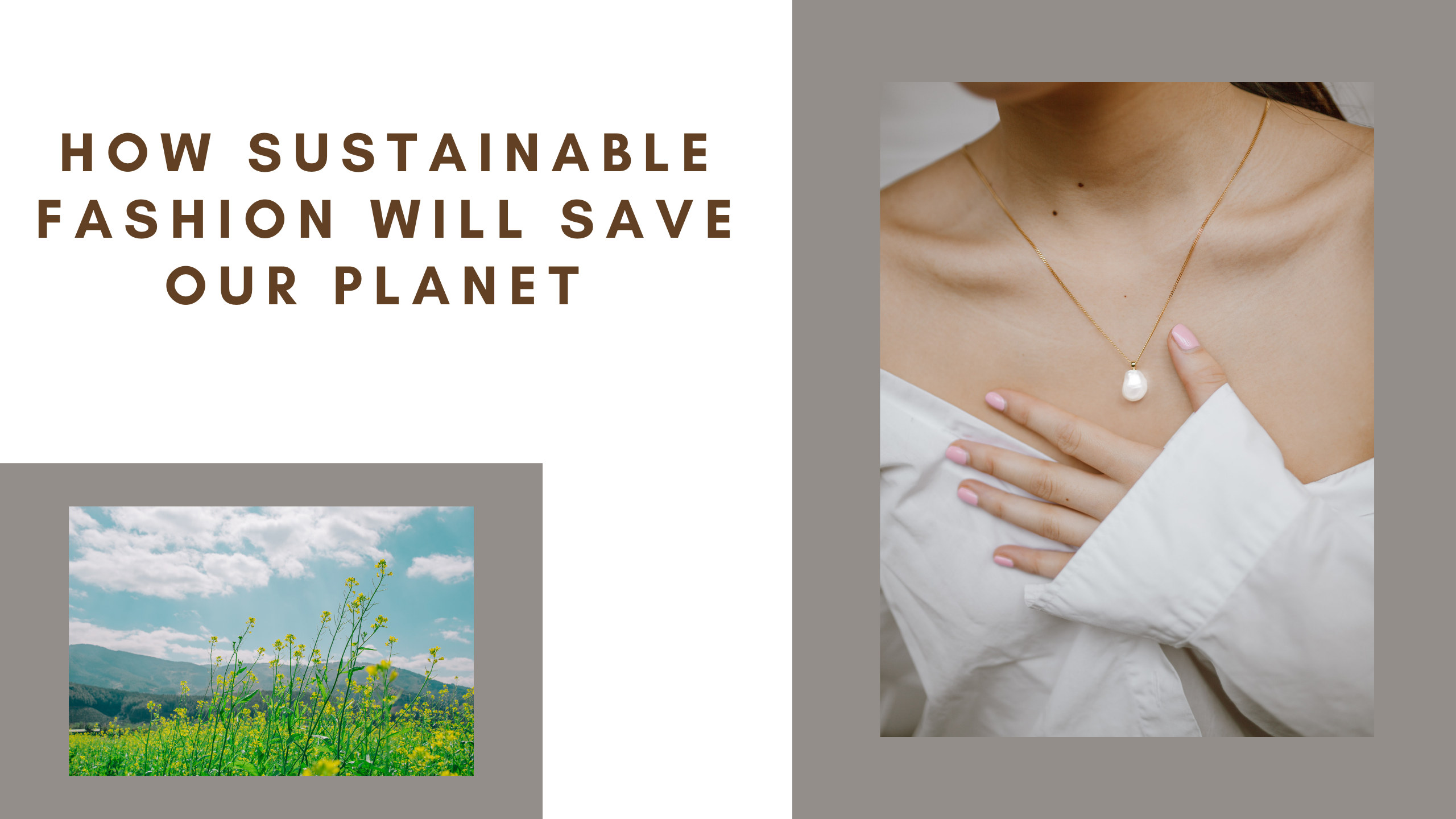
How Sustainable Fashion will save our planet
Have you ever thought how the clothing choices you make every day, impact our planet?
It’s hard to consider how the fashion industry can have such adverse effects on the environment, when it isn’t necessarily front of mind when we think climate disaster, land fill, pollution and other current issues we are facing today.
The truth is, this industry is one of the largest contributors, with 80 billion pieces of new clothing consumed globally every year1. This 400% increase, compared to 20 years ago, is largely thanks to the popularity of fast fashion which is “cheaply produced and priced garments that copy the latest catwalk styles and get pumped quickly through stores in order to maximise on current trends1.”

Buscher, N. (2018) [Stock Image] Unsplash
Luckily, to combat the impacts fast fashion brands are having on the environment, sustainable fashion is continuously on the rise, with a range of brands now offering more affordable and environmentally-conscious alternatives, for consumers of all types to invest in.
Education and awareness are the biggest barriers we now face when it comes to the impacts of the fashion industry, which is why we’re here to let you in on a few truths and have compiled a list of tips and tricks on how to be more sustainable with your wardrobe.
1. Fashion as a toxic gas emitter
When we think Greenhouse Gasses, we usually think cars, planes, mining amongst other things, but have you ever considered the clothes you wear, to be just as problematic?

Kolar, J (2019) [stock image] Unsplash
Fast fashion companies predominantly use cheap synthetic fibers (polyester, acrylic, nylon etc.) to produce their clothes, which unsurprisingly have significant environmental impacts.
Synthetic fibers “emit gasses like N2O, which is 300 times more dangerous than Co2” and take up to 70 million barrels of oil yearly to produce2.
To contrast, sustainable materials such as organic cotton, linen and hemp use significantly less to zero chemicals, little water, less energy as well as many being biodegradable3.The use of these materials will significantly help to reduce the emissions and toxicity from the current fashion industry and correct education and awareness will put sustainable, slow fashion at the forefront of consumer purchases.
2. Reality of owning too many clothes or what some may call… overconsumption
Whilst many of us grew up envying Carrie Bradshaw’s wardrobe in Sex and The City or longed after having the outfits like those you’d see in Gossip Girl, the reality is, that overconsumption within the fashion industry is one of the biggest contributors when it comes to landfill and toxic run offs.
Each year, Aussies are sending 85% of purchased textiles to landfill, making us only second to the US as the largest textile consumers globally1. To put this into context, an average family throws away approximately 30kg of clothing each year, with only 15% of total discarded garments recycled or donated4.
Unsurprisingly, 72% of our clothing are made from synthetic fibers which are non-biodegradable, which averages 200 years to decompose4. Whilst these garments are breaking down in land fill, waste such as plastic fibers, seep into the surrounding soil and waterways producing toxic run offs4.
It is time that we recognise the story behind our purchases and the implications this can have on our already fragile environment.
Keep reading for ways to incorporate sustainable fashion into your everyday lives.
3. The inhumanity you can’t see through display windows
Fashion is often used to tell a story…. except for the story of how the clothes came to be.

Lecatompessy, R. (2020) [Stock Image] Unsplash
The multi-million dollar brands that we buy our clothes from, often produce their products in countries where worker rights are non-existent, where minimum wage wouldn’t buy you a chocolate bar at the supermarket, where 170 million children are hired to do dangerous, back breaking work3… for what? Our new jacket?
The true story needs to be told and sustainable, trustworthy brands need to be the ‘new normal’ when it comes to our fashion purchasing decisions.
4. Curse of the industry promises… your favourite brands may be Greenwashing you!
Many of our favourite brands have pledged to become more sustainable in their materials, manufacturing and distributions… which is great right? Well unfortunately, many of these promises have a *huge asterisks* next to them.
Greenwashing refers to the “process of conveying a false impression or providing misleading information about how a company’s products are more environmentally sound5.”
The Changing Markets Foundation, commissioned a survey in 2018, to investigate the ethical promises and policies made by many fashion industry leaders, where the results were unfortunately appalling6.
Alden Wicker explained in a Vogue Business article that “a lack of standardised and legal binding framework to govern the information brands have to disclose has given them the ability to describe their own sustainability-led initiatives, marketing campaigns and capsule collections6” this allows room for a misleading and selective narrative to be created for consumers6.
5. Ways to sustain… slow (fashion) down there!
So, now that we’ve educated you on some of the impacts the current fashion industry are having on our planet and environment, Here are some ways on how we can fix this, and become sustainable fashionistas!

Du Perez, D. (2017) [Stock Image] Unsplash
- Use the #30wears test! Created by Livia Firth, founder of Eco Age, ask yourself if you will wear the item a minimum of 30 times? If the answers no… you and the planet are better off without it7!
- Quality over Quantity, now you are more informed about fast fashions harmful impacts, it’s time for a mindset change to invest in quality pieces7
- Look for sustainable materials! 100% Organic Cotton, ECONYL, Organic linen… there is a huge list over at Sustainable Jungle for you to check out! https://www.sustainablejungle.com/sustainable-fashion/sustainable-fabrics/
- Donate your pre-loved clothes (Vinnies, Red Cross, homeless shelters etc.)
- Learn to repair and re-invent the clothes you already have
The time to make a change is right now. Education and action are the most important ingredients for re-building our planet, so be sure to share this article across your social media platforms to make sustainable fashion the trend that never goes out of style.
Referenced Sources:
1. The University of Queensland. (n.d.). Fast fashion quick to cause environmental havoc. https://sustainability.uq.edu.au/projects/recycling-and-waste-minimisation/fast-fashion-quick-cause-environmental-havoc
2. Conca, J. (2015). Making Climate Change Fashionable- The Garment Industry Takes on Global Warming.https://www.forbes.com/sites/jamesconca/2015/12/03/making-climate-change-fashionable-the-garment-industry-takes-on-global-warming/?sh=5cc8028079e4
3. Bielawski, K. (n.d.). 8 Reasons Why Sustainable Fashion Matters. https://www.narahsoleigh.com/blogs/blog/8-reasons-why-sustainable-fashion-matters
4. Charpail, M. (2017). The Fashion Industry is the Second Largest Polluter in the World. https://www.sustainyourstyle.org/old-environmental-impacts
5. Kenton, W. (2021). Greenwashing. https://www.investopedia.com/terms/g/greenwashing.asp
6. Wicker, A. (2020). The Flawed Ways Brands Talk About Sustainability.https://www.voguebusiness.com/sustainability/the-flawed-ways-brands-talk-about-sustainability-coronavirus
7. Davis, J. (2021). 10 simple steps to being more sustainable.https://www.harpersbazaar.com/uk/fashion/what-to-wear/a41158/how-to-be-sustainable-fashion/
